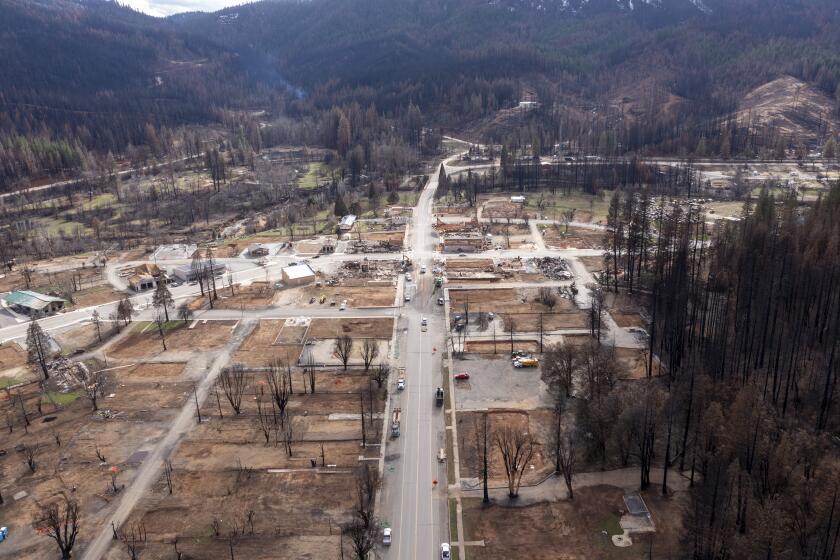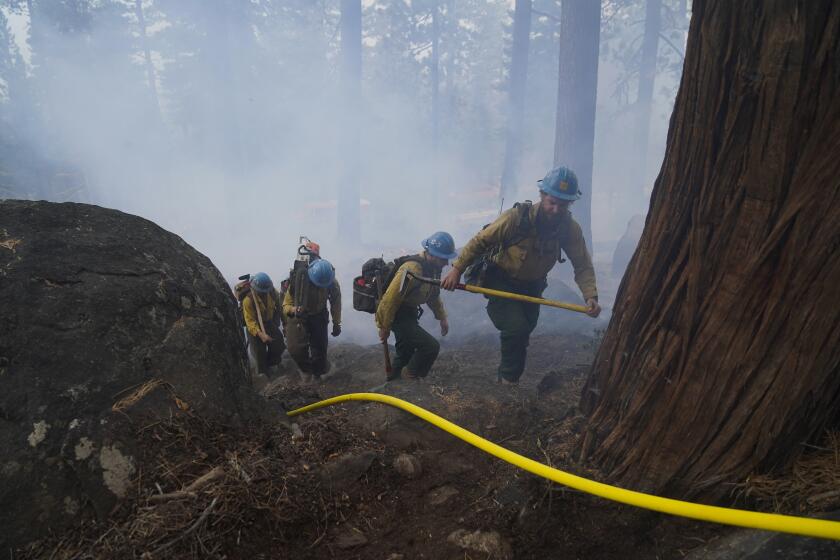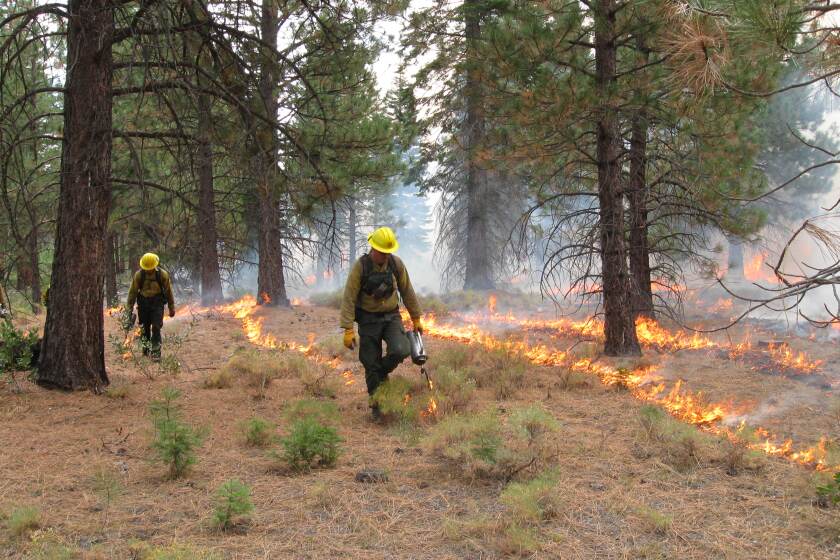California fires are so severe some forests might vanish forever
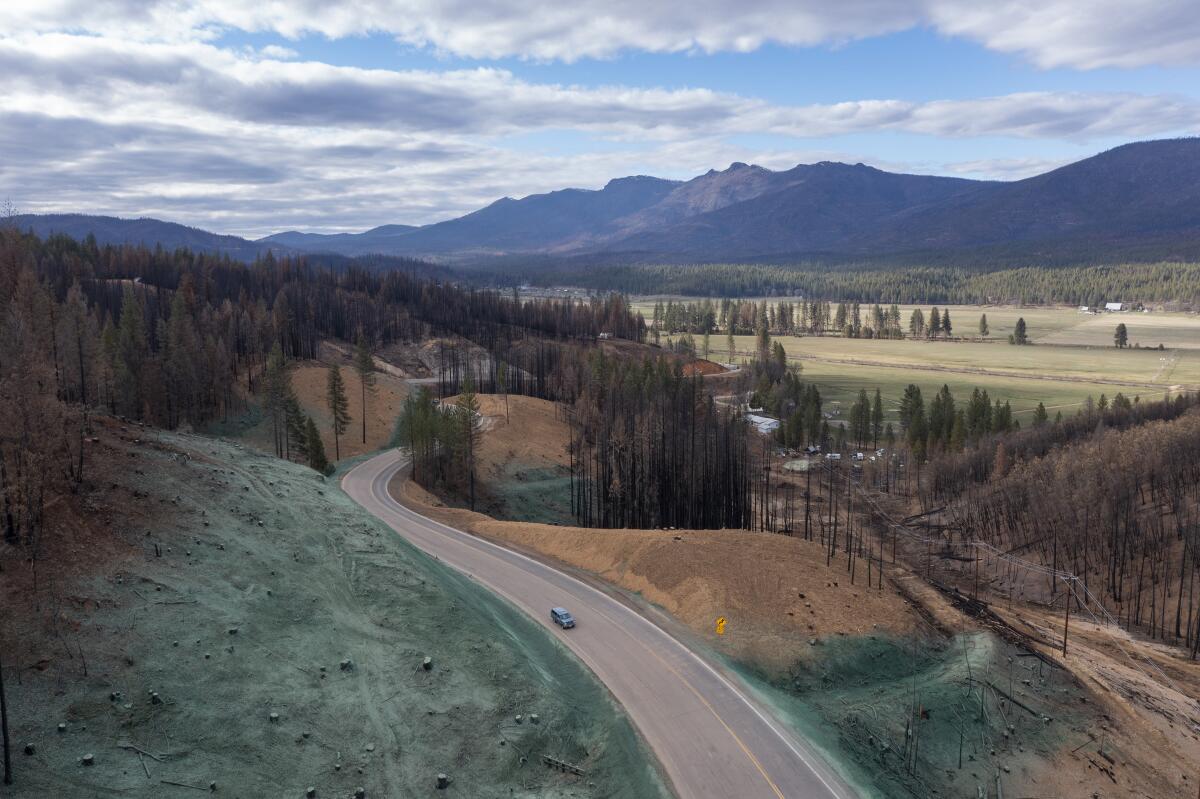
- Share via
GREENVILLE, Calif. — A burn scar in Northern California offers an unsettling glimpse into what forests across the Sierra Nevada could become. Bare tree carcasses are strewn across the dun-colored hills. Rock outcroppings jut out like bones.
Two massive wildfires have torn through here over the last 15 years, burning with such intensity through so large an area that the conifer forest will likely be unable to regenerate on its own, experts say.
It’s a pattern that threatens to repeat across California’s most extensive and iconic mountain range as wildfires have increased in both size and severity over the last two decades.
“Because the last couple years have been so massive for fires, the forests don’t have a chance to keep up or recover in time,” said Jon Wang, an earth system scientist at UC Irvine. “There is an acceleration of the fire regime that is overwhelming these forests.”
The Moonlight fire blazed a 100-square-mile footprint through these mountains in 2007. About 60% burned at high severity, killing most or all of the vegetation, said Jonathan Kusel, founder and executive director of the nonprofit Sierra Institute for Community and Environment. Swaths of conifer forest were replaced by shrubs, which increased from an estimated 2% of the fire’s footprint to 29%, he said.
Thanks to reforestation efforts by federal, state and nonprofit organizations, roughly 14 years later, oaks were beginning to sprout here again. Vegetation, though scraggly, was helping to hold the soil in place. Bird surveys were starting to reveal a slow-growing increase in diversity.
That was until last summer, when the nearly 1-million-acre Dixie fire burned through.
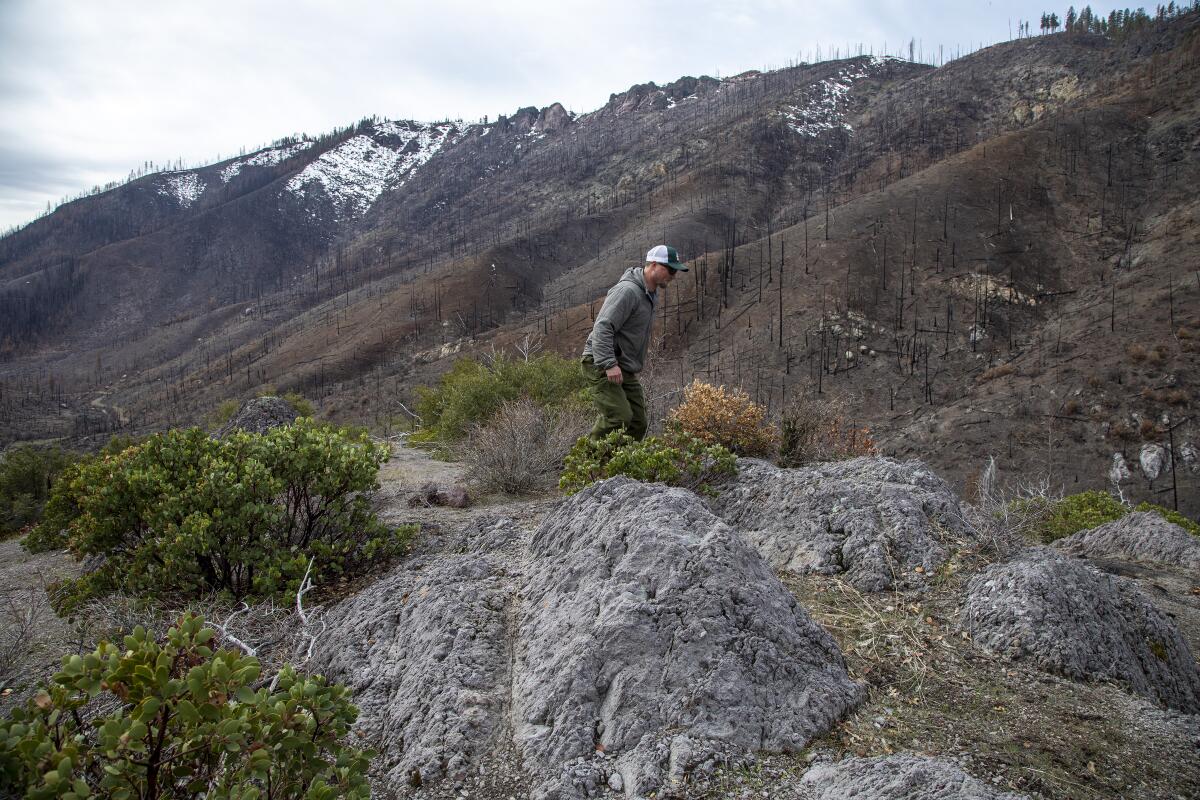
“The concern is the amount of conifer forest that we’ve lost won’t recover,” said Ryan Bauer, fuels and prescribed fire program manager for the Plumas National Forest. “The patches of high-severity fire are so big that there’s not a seed source near enough to get conifer forest reestablished naturally in these large patch sizes.”
About 1.5 million acres of the Sierra Nevada burned last fire season. That surpassed 2020, when almost 1 million acres burned, which itself was more than double the previous record set in 2018, according to data from the Sierra Nevada Conservancy. A study by researchers at UC Irvine and UC Davis found that solely considering rising summer temperatures, the acreage burned will increase by up to 92% by the 2040s.
Even more alarming is the type and distribution of these fires. About 575,000 acres of the Sierra Nevada burned at high severity last year, including four individual patches of more than 62 square miles each. The conservancy estimates that’s more than 18 times the average amount of high-severity fire seen by the Sierra some 100 years ago, when Indigenous people like the Mountain Maidu regularly tended its forests with low-intensity cultural burns and naturally sparked fires were not suppressed.
Efforts are underway to rebuild Greenville, Calif., from the ashes of the Dixie fire. Can it be made to survive the next wildfire?
A landscape’s fire regime — the pattern, frequency and intensity of fire particular to that area — determines what vegetation grows there, Bauer said.
“By removing fire, we’ve set this up to be a whole different fire regime, which is a whole different [vegetation] type,” he said. “So we’ve essentially managed this landscape to become a brush field.”
The Sierra Nevada has lost 8.8% of its tree cover, since 1985, while shrub cover has increased by 4.4%, according to a recent study by researchers at UC Irvine and UC Berkeley, who were able to quantify the loss for the first time due to advances in satellite technology and data science.
Statewide, tree cover has fallen 6.7% over the same time period, according to the study in AGU Advances. Researchers found an increase in catastrophic wildfire to be the main driver.
Study authors attribute this to a “perfect storm” of factors. Decades ago, the U.S. government outlawed Indigenous burning and began aggressively suppressing even naturally sparked fires, resulting in a buildup of vegetation in some forests. More recently, increasing temperatures because of climate change have caused fires to ignite more easily, spread more rapidly, grow larger and burn higher.
Heat and drought have also stoked fires by killing trees, both directly and by making them more vulnerable to bark beetle infestations. The dry, dead trees have grown flammable, helping turn lower-intensity surface fires into more damaging crown fires, the researchers said.
The result has been fires that are much larger and more intense than the forests are used to, said Wang, a postdoctoral scholar and lead author of the study.
The research provides evidence that these forests haven’t reached a new steady state in the midst of the altered fire regime, resulting in a net loss of trees, said co-author Jim Randerson, professor of earth system science at UC Irvine.
“And it’s more than that: There’s evidence for a slower recovery after fires as well that may be driven by extra warming we’ve experienced over the last 35 years or so,” he said.
Whether some trees will eventually regrow, or the losses will at least stabilize, as forests adjust to the new regime remains an open question — one that poses a major concern, Wang and Randerson said.
“If we’re able to come up with a better solution to manage forests and fires drop back; if we’re also able to stabilize the climate, that may lead to larger areas of forest that are maintained,” Randerson said. “And if climate change continues at pace through the middle part of the 20th century, then we are in a position where it’s my expert judgment that we’re going to lose considerably more forest area.”
A federal firefighter’s viral resignation letter is highlighting the job’s low pay and harsh working conditions in the age of climate change.
At the heart of the Moonlight fire was private timber land, whose owners tend to remove the largest, most fire-resilient trees and leave behind smaller trees and brush, Bauer said. That resulted in a buildup of surface fuels that also may have helped drive high-intensity fire, he said.
Researchers at Princeton University and UC Berkeley recently analyzed 154 fires that burned nearly 2.4 million acres in California from 1985 to 2019 and found that the odds of fires burning at high severity on private industrial land were 1.8 times greater than on public lands. That might be due to the prevailing land management practice of cultivating dense, even-aged plantations that create continuous high fuel loads, they hypothesized.
The study, published in Frontiers in Ecology and the Environment, also found a higher incidence of high-severity fire on land adjacent to private industrial land, which is significant due to the checkerboard pattern of land ownership in the state, said author Jacob Levine of Princeton. About 26% of the land in the study’s footprint is private industrial, and another 25% is within about half a mile of private industrial land, he said.
“These properties don’t exist in a vacuum — they really interact with each other,” he said. “Fire is a contiguous process that doesn’t care about where the property line begins and ends.”
The results underscore the need for cooperation between public agencies and the private sector to tackle the problem of increasing high-severity fire, he said.
These land management choices have been compounded by steadily warming temperatures and drought that have made vegetation more combustible, creating what Bauer calls “a canary in the coal mine for climate change.”
The effects are uniquely ecologically devastating for a mountain range that stores half of California’s forest carbon and provides more than 60% of the state’s developed water supply, according to the Sierra Nevada Conservancy.
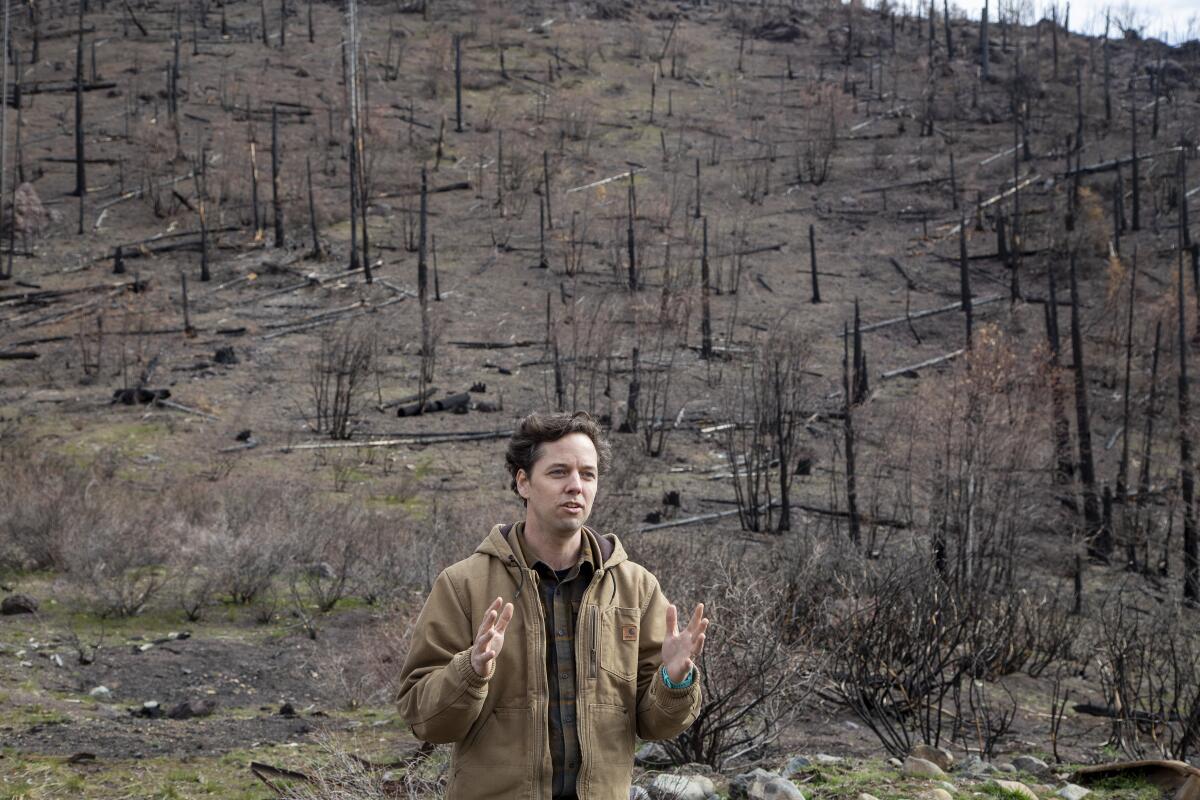
“Conifer forests sequester and store far more carbon than shrubs and oaks do,” said Elliott Vander Kolk, regional forester for the Sierra Nevada Conservancy. “And the wildlife species that depend on that old forest type no longer have this as a place where they can be, and they’re not set back on the stage to develop that over a reasonable timeframe.”
Additionally, sediment washing down from burned hillsides diminishes water quality and can reduce reservoir storage, Kusel said.
These landscapes also become more susceptible to future conflagrations as dense, fire-killed timber falls to the ground and brush grows over top and dries out, creating a flammable mix that releases massive amounts of energy when it burns, Bauer said. Forest Service studies have shown that areas that burn at high severity are statistically more likely to reburn at high severity. Each time that happens, the surviving green patches grow smaller. The result is a feedback loop that becomes increasingly difficult to interrupt.
“You look up on this landscape and that right there, that was green after the Moonlight fire,” he said, pointing to a small stand of trees. “But now it’s a little less green. Same over there. And so this cycle of perpetuating high severity events is eventually going to whittle away our remaining conifer forest if we don’t get ahead of it.”
High-severity fire puts at risk entire communities like Grizzly Flats, which was leveled by last year’s Caldor fire. Not far from this burn scar, the Dixie fire destroyed the town of Greenville when flames erupted into an uncontrollable crown fire, which can gain speed as it spreads from treetop to treetop.
Now, the forests immediately surrounding Greenville are set up for the same scenario of repeating high-severity fires unless authorities remove a significant number of standing dead trees, Bauer said. He figures they have eight to 12 years to complete that work before another landscape-scale fire burns through.
It’s a monumental task. And given the rapidly changing nature of the climate and wildfires, simply replanting is no longer enough, Bauer said. He pointed to the reforestation efforts destroyed by the Dixie fire as evidence.
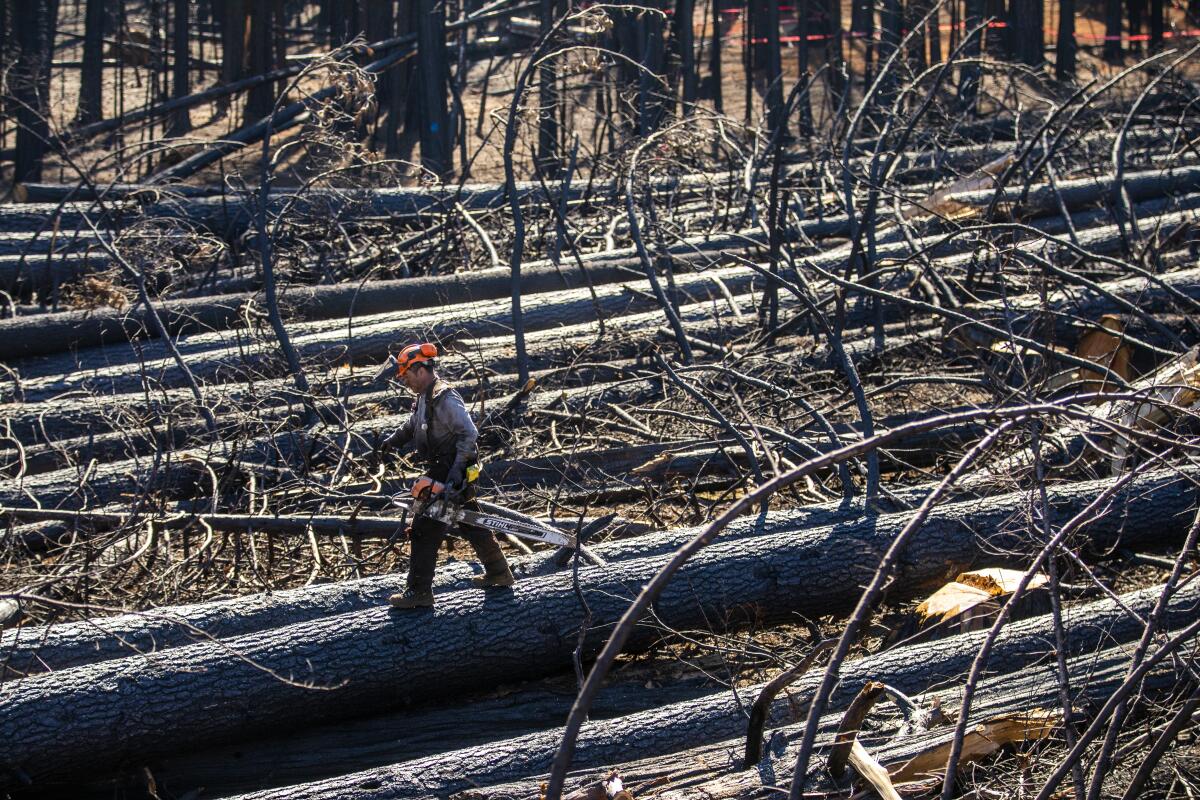
“Our old strategy of trying to spread plantations across the landscape, it’s not really working out,” he said. “They’re too susceptible to wildfire. Unless the landscape around them is also treated, they’re not going to survive the next fire in most cases.”
Stakeholders must figure out new restoration methods that better protect the surviving green patches, he said. One key piece is getting low-severity fire back on the ground in the right places at the right times — research has shown that this makes it more likely that the land will reburn at low severity in the next wildfire, Bauer said. Oftentimes, that requires first thinning vegetation to create conditions under which fire can be reintroduced safely, he said.
About two months after the tour of the burn scar, the Forest Service announced it was pausing prescribed burns while it conducted a 90-day review after a burn in New Mexico escaped control and became the largest wildfire in state history. Still, the agency said the break would have minimal impact because 90% of its prescribed fire operations take place between September and May.
Even as evidence mounts that prescribed burns are effective in reducing wildfire risk, the U.S. Forest Service and other agencies are falling behind.
Agencies like the Forest Service must exponentially increase the scale of their work and forge partnerships to ensure it extends across jurisdictional boundaries, Bauer said.
“We can be successful on thousands of acres,” he said. “But we need to be successful on tens of thousands of acres, or hundreds of thousands of acres.”
Bauer recalled a recent Forest Service meeting at which the supervisor asked attendees to name the biggest priority for the Plumas.
“And I said, frankly, I think we have a tiny opportunity to buffer the communities and the watershed and what’s really important on this landscape from the unprecedented change that we’re about to witness,” Bauer said. “And that’s probably all we have, like we have a little opportunity to do some triage.”
Although the wildfire peril facing the Sierra Nevada is unprecedented, so is the level of investment aimed at addressing it, said Angie Avery, executive officer of the Sierra Nevada Conservancy. The state and federal government have together earmarked billions of dollars for resilience projects and announced plans to dramatically increase how much land is treated with thinning and prescribed fire.
For the first time, a broad consensus has emerged among scientists, legislators and many environmental groups that human intervention is required to salvage these forests, she said.
“I think the administration and folks understand now that we’ve got to invest in proactive forest management,” Avery said. “The unfortunate thing, though, is that we’re seeing change on the landscape happen more quickly than the funding is being made available.”
More to Read
Sign up for Essential California
The most important California stories and recommendations in your inbox every morning.
You may occasionally receive promotional content from the Los Angeles Times.
